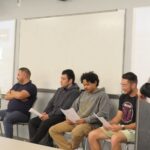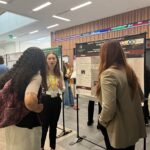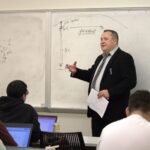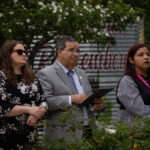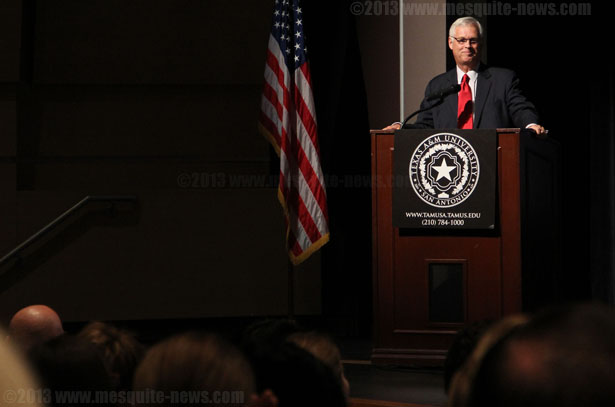
By Alma Linda Manzanares
Convocation celebrated the academic partnership between Texas A&M-San Antonio and the Alamo Colleges Thursday in the Performing Arts Center at Palo Alto College. Alamo Colleges Chancellor Bruce Leslie delivered the keynote address which focused on three objectives: the academic partnership, fears involving higher education and initiatives implemented by the Alamo Colleges.
Palo Alto is located directly north of the university’s Main Campus.
Leslie welcomed A&M-San Antonio to Palo Alto by recalling the initial size of the campus and the limited facilities recalling that no one thought the college would amount to anything. “Remember this is the South Side of San Antonio,” he said.
Palo Alto was opened in 1985 with 231 students after South Side residents fought for a higher education institution in South Bexar County.
Since then, Leslie said Palo Alto has grown into a “real college campus” and has more students attending than the average community college. The college had an enrollment of 17,077 student for fiscal year 2012-2013. “The Alamo Colleges itself is one of the largest in the country at almost 100,000 students,” he said.
A&M-San Antonio became a stand-alone university in 2009, offering junior- and senior-level courses for South Side residents. Before, the university was established as the Texas A&M University-Kingsville System Center-San Antonio in 2000.
As he addressed the academic partnership between the Alamo Colleges and A&M-San Antonio, Leslie recalled President Maria Hernandez Ferrier’s journey through San Antonio College. “I’ve been charmed, as everyone has been, by Dr. Ferrier,” he said. “Since she attended San Antonio College, we had something to do with her success and we are very, very proud of that.” Ferrier was awarded the Outstanding Former Student Award at SAC’s 2010 commencement ceremony.
Ferrier has reached out to him and vice versa Leslie said, because both realize how important A&M-San Antonio and Alamo Colleges are to the city, especially the South Side community. “She says all the time, ‘Your students are our students.’ My team and I believe in that, agree with that and continue to strive to achieve that vision that our students are your students,” Leslie said.
Leslie asked the faculty how students from the Alamo Colleges were doing at A&M-San Antonio. The question was followed by a moderate applause from faculty. Leslie said he would’ve preferred a stronger applause and later urged faculty and staff to provide feedback.
Leslie’s second objective focused on his fears: the railing of higher education, legislators controlling how to run an institution and potentially disappointing families who have students enrolled at the Alamo Colleges.
He said the railing is blamed on the economic downturn. “I can assure you, that just became a vehicle to help promote the agenda of dramatically changing education,” Leslie said. He added that President Barack Obama was currently on a bus tour from upstate New York to northeastern Pennsylvania to promote lowering college costs.
Thursday morning, Obama spoke at the University at Buffalo about a proposed government rating system for colleges that would judge schools on affordability and performance to determine how federal financial aid is distributed. The rating system, which Obama wants to take effect before the 2015 school year, would rate colleges based on a criteria that includes tuition prices, graduation rates, debt and earnings of graduates, and the percentage of lower-income students who attend. Obama hopes the ratings will be tied to financial aid by 2018.
“What scares me is legislators, governors, etc. will take the initiative and make decisions about how we are to do our work,” Leslie said.
Leslie said he is scared that the colleges will not live up to the hope families have for their students to succeed at the Alamo Colleges. He said the academic partnership with A&M-San Antonio is important because he wants students to succeed at the Alamo Colleges and have them transfer.
“One of the challenges that we all have is that people on one hand have a great deal of hope for us but frankly, there is a society out there that’s lost their trust in us,” Leslie said. “We’ve got to help the public appreciate what we do, value what we do.”
Leslie’s third objective focused on Alamo Colleges initiatives implemented over the course of his seven years as chancellor. Prior to his role, Leslie serve as Chancellor of the Houston Community College System and the Connecticut Community-Technical Colleges. He served as president of Onondaga Community College in Syracuse, New York.
Leslie discussed the revision of the advising model as an initiative implemented by the colleges. “We’re establishing an active intervention, case management approach to advising,” Leslie said. “This is a continuous engagement process with advisers and the students.” He said any milestone in a student’s life that causes them to reduce their course load or drop courses is dealt with through the student’s adviser. Leslie added that the Alamo Colleges has invited A&M-San Antonio faculty and staff to advising workshops to share this method of advising.
Another invitation that has been extended to A&M-San Antonio is a national conference focused on the Franklin Covey company leadership training program. Leslie said the company has been supportive partners to develop a leadership certification program for all Alamo College students. He recommended that faculty and staff read “The 7 Habits of Highly Effective People” by Stephen R. Covey, which the Alamo Colleges’ employee leadership program, Student Leadership Institute and employers in the community all use.
Although the Alamo College’s has a Student Leadership Institute, the program only serves about 80 to 100 students a year. According to the college’s website, the program provides students the opportunity to develop their leadership potential by becoming proactive, productive, and engaging leaders on campus and in the workplace and community. Students engage in dialogue and participate in a leadership course, leadership labs and civic engagement. “This is a wonderful program, these students love this thing and it’s having a positive impact on their transfer and their employment,” Leslie said.
Leslie said the colleges are focused on developing a leadership certification program because employer community feedback has shown that graduates of the Alamo Colleges don’t know how to engage in an organization and be responsible, accountable and proactive. He added that at commencement ceremonies, he also notices how students do not know how to shake hands or look him directly in the eye.
“I’m thinking, ‘And they’re going to an interview after this? How are they going to get employed?’” Leslie said. “And, the women are wearing rings that are literally causing my hand to bleed by the end of the event.”
After Leslie’s keynote address, Ferrier said she feels “very comfortable” that the model developing between the Alamo Colleges and A&M-San Antonio will become a model for the state on how community colleges and universities work together to meet the needs of higher education.
“Our students are Alamo College students,” Ferrier said. She said 85 percent of the university’s students come from one of the five Alamo Colleges.
A&M-San Antonio growth
Overall, A&M-San Antonio is the fastest growing university in the state, Ferrier said. She said the university has experienced a 190 percent growth since 2008. Ferrier added university statistics: the average student is 32-years-old, 67 percent are females and 64 percent are Hispanic.
Student organizations have undergone rapid growth. Ferrier said in 2008, the university only had three student organizations. She said there are now 45 student organizations.
Ferrier also announced new programs in the college of arts and sciences and college of business. In the college of arts and sciences, new undergraduate programs include STEM, social sciences, the humanities, the arts, public administration and nursing. Future graduate programs include water resource studies, geographic information sciences, biology and social work.
Ferrier said in the college of business, future plans include a master’s program in information technology, flexible program formats and launching an e-portfolio requirement for graduation.


